Graduate Certificate in Diabetic Management Plan | Report
VerifiedAdded on 2022/09/09
|14
|2848
|20
AI Summary
Contribute Materials
Your contribution can guide someone’s learning journey. Share your
documents today.
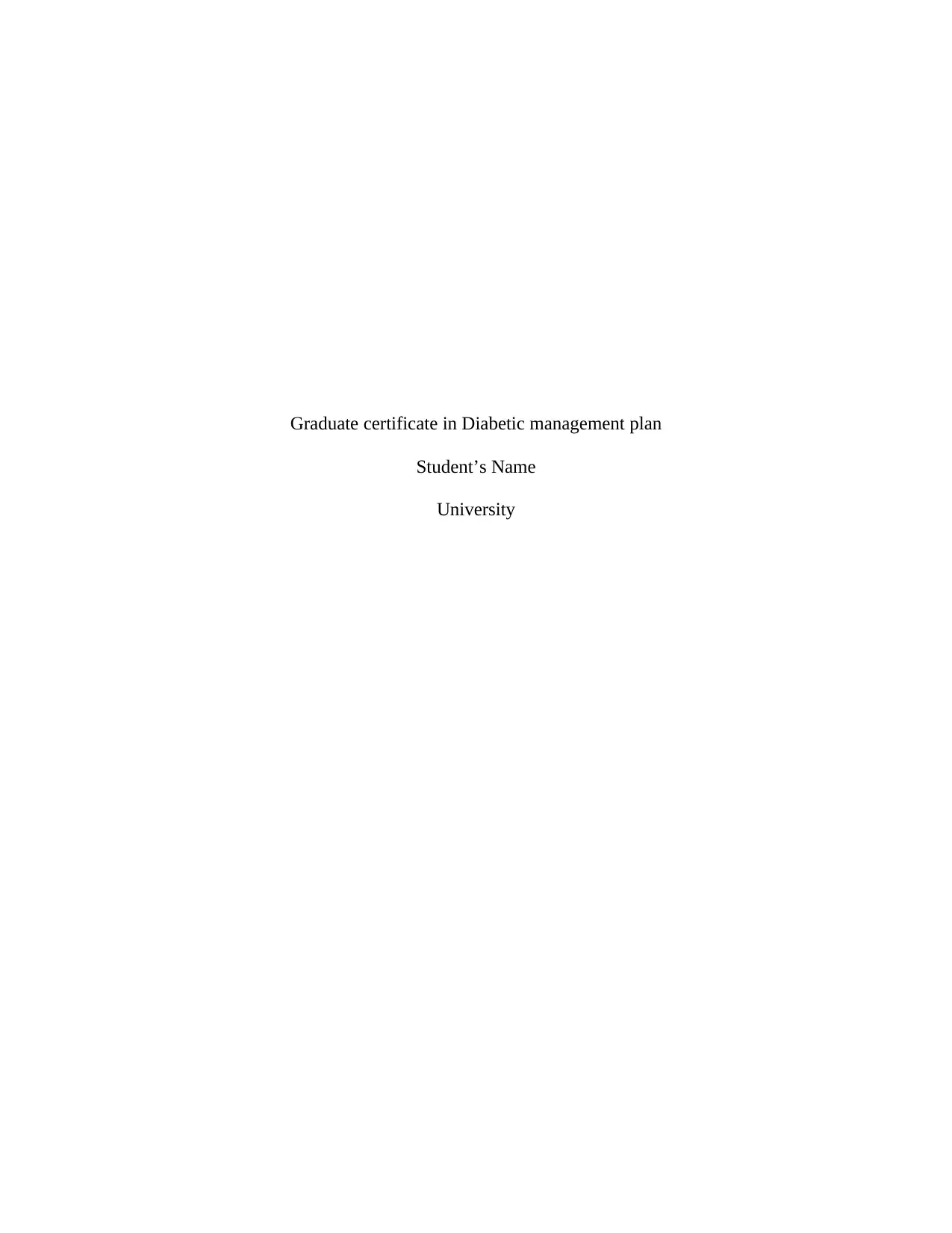
Graduate certificate in Diabetic management plan
Student’s Name
University
Student’s Name
University
Secure Best Marks with AI Grader
Need help grading? Try our AI Grader for instant feedback on your assignments.
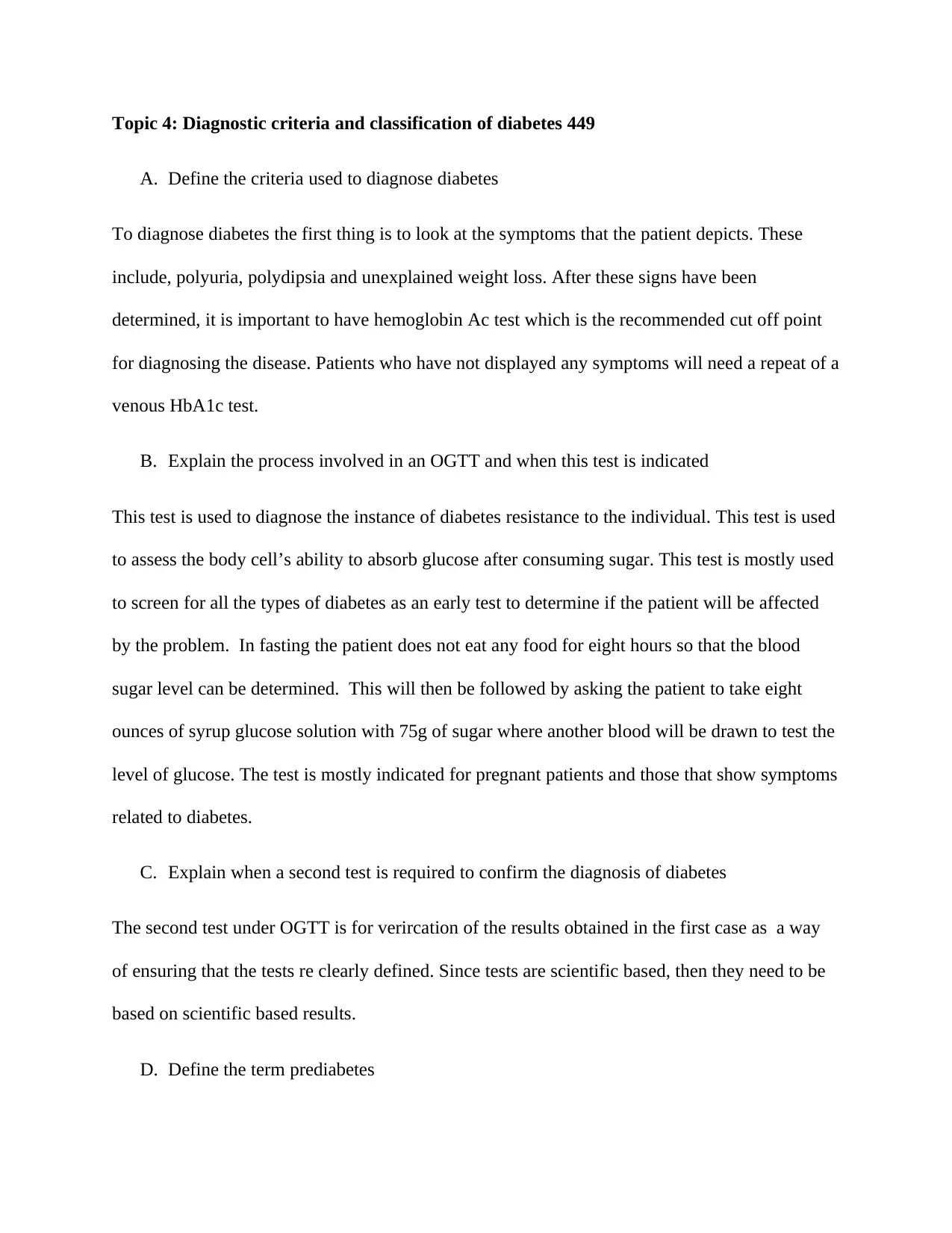
Topic 4: Diagnostic criteria and classification of diabetes 449
A. Define the criteria used to diagnose diabetes
To diagnose diabetes the first thing is to look at the symptoms that the patient depicts. These
include, polyuria, polydipsia and unexplained weight loss. After these signs have been
determined, it is important to have hemoglobin Ac test which is the recommended cut off point
for diagnosing the disease. Patients who have not displayed any symptoms will need a repeat of a
venous HbA1c test.
B. Explain the process involved in an OGTT and when this test is indicated
This test is used to diagnose the instance of diabetes resistance to the individual. This test is used
to assess the body cell’s ability to absorb glucose after consuming sugar. This test is mostly used
to screen for all the types of diabetes as an early test to determine if the patient will be affected
by the problem. In fasting the patient does not eat any food for eight hours so that the blood
sugar level can be determined. This will then be followed by asking the patient to take eight
ounces of syrup glucose solution with 75g of sugar where another blood will be drawn to test the
level of glucose. The test is mostly indicated for pregnant patients and those that show symptoms
related to diabetes.
C. Explain when a second test is required to confirm the diagnosis of diabetes
The second test under OGTT is for verircation of the results obtained in the first case as a way
of ensuring that the tests re clearly defined. Since tests are scientific based, then they need to be
based on scientific based results.
D. Define the term prediabetes
A. Define the criteria used to diagnose diabetes
To diagnose diabetes the first thing is to look at the symptoms that the patient depicts. These
include, polyuria, polydipsia and unexplained weight loss. After these signs have been
determined, it is important to have hemoglobin Ac test which is the recommended cut off point
for diagnosing the disease. Patients who have not displayed any symptoms will need a repeat of a
venous HbA1c test.
B. Explain the process involved in an OGTT and when this test is indicated
This test is used to diagnose the instance of diabetes resistance to the individual. This test is used
to assess the body cell’s ability to absorb glucose after consuming sugar. This test is mostly used
to screen for all the types of diabetes as an early test to determine if the patient will be affected
by the problem. In fasting the patient does not eat any food for eight hours so that the blood
sugar level can be determined. This will then be followed by asking the patient to take eight
ounces of syrup glucose solution with 75g of sugar where another blood will be drawn to test the
level of glucose. The test is mostly indicated for pregnant patients and those that show symptoms
related to diabetes.
C. Explain when a second test is required to confirm the diagnosis of diabetes
The second test under OGTT is for verircation of the results obtained in the first case as a way
of ensuring that the tests re clearly defined. Since tests are scientific based, then they need to be
based on scientific based results.
D. Define the term prediabetes
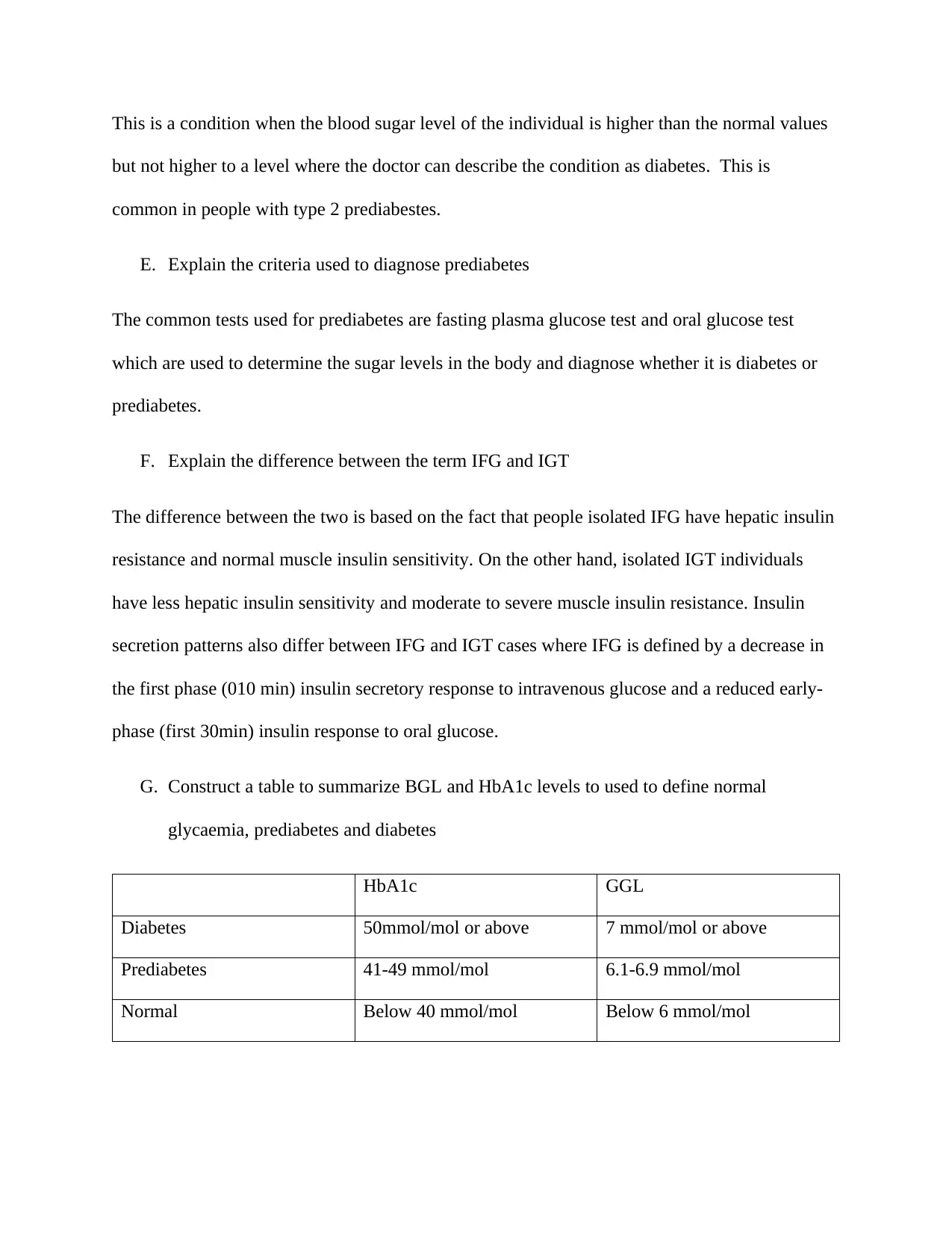
This is a condition when the blood sugar level of the individual is higher than the normal values
but not higher to a level where the doctor can describe the condition as diabetes. This is
common in people with type 2 prediabestes.
E. Explain the criteria used to diagnose prediabetes
The common tests used for prediabetes are fasting plasma glucose test and oral glucose test
which are used to determine the sugar levels in the body and diagnose whether it is diabetes or
prediabetes.
F. Explain the difference between the term IFG and IGT
The difference between the two is based on the fact that people isolated IFG have hepatic insulin
resistance and normal muscle insulin sensitivity. On the other hand, isolated IGT individuals
have less hepatic insulin sensitivity and moderate to severe muscle insulin resistance. Insulin
secretion patterns also differ between IFG and IGT cases where IFG is defined by a decrease in
the first phase (010 min) insulin secretory response to intravenous glucose and a reduced early-
phase (first 30min) insulin response to oral glucose.
G. Construct a table to summarize BGL and HbA1c levels to used to define normal
glycaemia, prediabetes and diabetes
HbA1c GGL
Diabetes 50mmol/mol or above 7 mmol/mol or above
Prediabetes 41-49 mmol/mol 6.1-6.9 mmol/mol
Normal Below 40 mmol/mol Below 6 mmol/mol
but not higher to a level where the doctor can describe the condition as diabetes. This is
common in people with type 2 prediabestes.
E. Explain the criteria used to diagnose prediabetes
The common tests used for prediabetes are fasting plasma glucose test and oral glucose test
which are used to determine the sugar levels in the body and diagnose whether it is diabetes or
prediabetes.
F. Explain the difference between the term IFG and IGT
The difference between the two is based on the fact that people isolated IFG have hepatic insulin
resistance and normal muscle insulin sensitivity. On the other hand, isolated IGT individuals
have less hepatic insulin sensitivity and moderate to severe muscle insulin resistance. Insulin
secretion patterns also differ between IFG and IGT cases where IFG is defined by a decrease in
the first phase (010 min) insulin secretory response to intravenous glucose and a reduced early-
phase (first 30min) insulin response to oral glucose.
G. Construct a table to summarize BGL and HbA1c levels to used to define normal
glycaemia, prediabetes and diabetes
HbA1c GGL
Diabetes 50mmol/mol or above 7 mmol/mol or above
Prediabetes 41-49 mmol/mol 6.1-6.9 mmol/mol
Normal Below 40 mmol/mol Below 6 mmol/mol
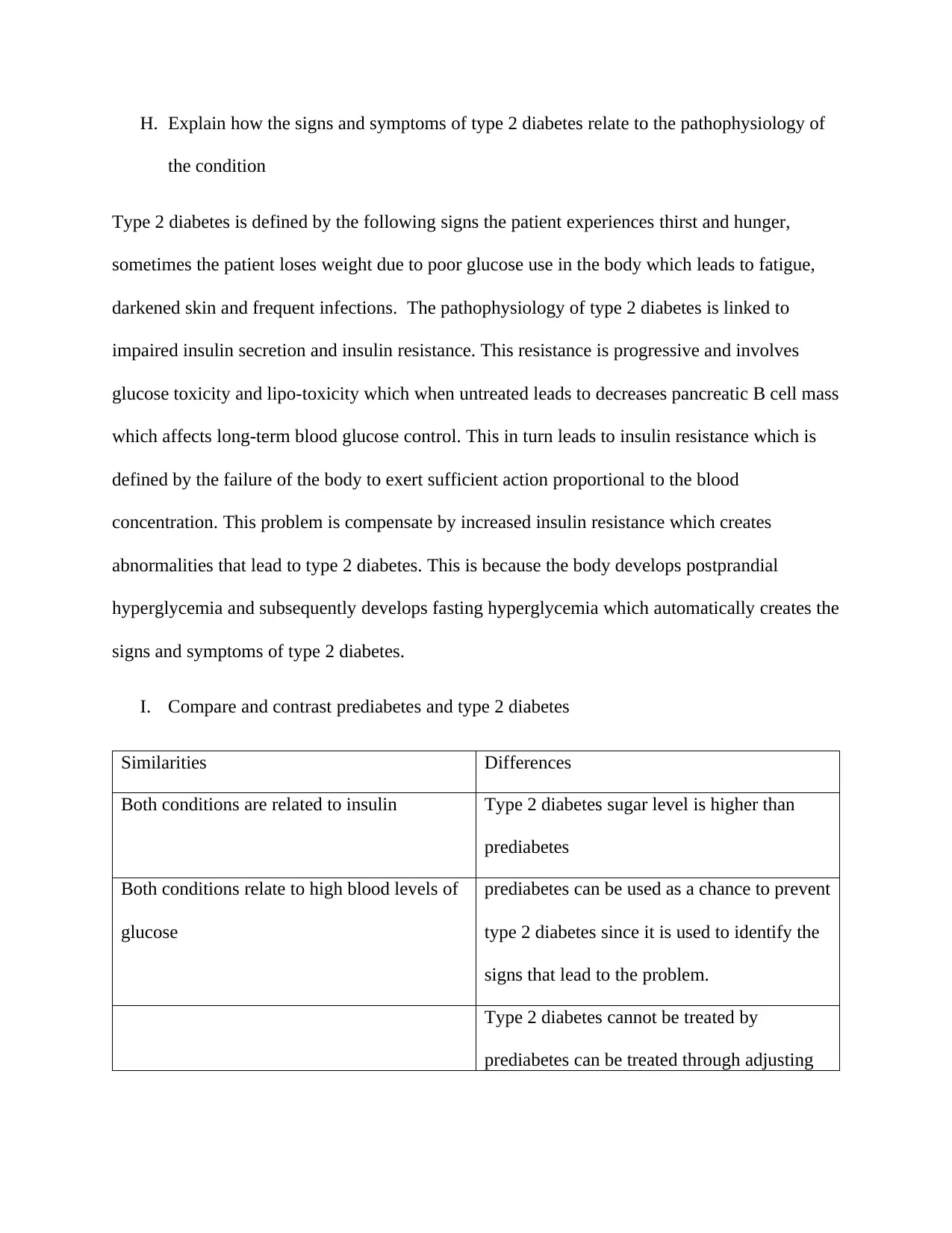
H. Explain how the signs and symptoms of type 2 diabetes relate to the pathophysiology of
the condition
Type 2 diabetes is defined by the following signs the patient experiences thirst and hunger,
sometimes the patient loses weight due to poor glucose use in the body which leads to fatigue,
darkened skin and frequent infections. The pathophysiology of type 2 diabetes is linked to
impaired insulin secretion and insulin resistance. This resistance is progressive and involves
glucose toxicity and lipo-toxicity which when untreated leads to decreases pancreatic B cell mass
which affects long-term blood glucose control. This in turn leads to insulin resistance which is
defined by the failure of the body to exert sufficient action proportional to the blood
concentration. This problem is compensate by increased insulin resistance which creates
abnormalities that lead to type 2 diabetes. This is because the body develops postprandial
hyperglycemia and subsequently develops fasting hyperglycemia which automatically creates the
signs and symptoms of type 2 diabetes.
I. Compare and contrast prediabetes and type 2 diabetes
Similarities Differences
Both conditions are related to insulin Type 2 diabetes sugar level is higher than
prediabetes
Both conditions relate to high blood levels of
glucose
prediabetes can be used as a chance to prevent
type 2 diabetes since it is used to identify the
signs that lead to the problem.
Type 2 diabetes cannot be treated by
prediabetes can be treated through adjusting
the condition
Type 2 diabetes is defined by the following signs the patient experiences thirst and hunger,
sometimes the patient loses weight due to poor glucose use in the body which leads to fatigue,
darkened skin and frequent infections. The pathophysiology of type 2 diabetes is linked to
impaired insulin secretion and insulin resistance. This resistance is progressive and involves
glucose toxicity and lipo-toxicity which when untreated leads to decreases pancreatic B cell mass
which affects long-term blood glucose control. This in turn leads to insulin resistance which is
defined by the failure of the body to exert sufficient action proportional to the blood
concentration. This problem is compensate by increased insulin resistance which creates
abnormalities that lead to type 2 diabetes. This is because the body develops postprandial
hyperglycemia and subsequently develops fasting hyperglycemia which automatically creates the
signs and symptoms of type 2 diabetes.
I. Compare and contrast prediabetes and type 2 diabetes
Similarities Differences
Both conditions are related to insulin Type 2 diabetes sugar level is higher than
prediabetes
Both conditions relate to high blood levels of
glucose
prediabetes can be used as a chance to prevent
type 2 diabetes since it is used to identify the
signs that lead to the problem.
Type 2 diabetes cannot be treated by
prediabetes can be treated through adjusting
Secure Best Marks with AI Grader
Need help grading? Try our AI Grader for instant feedback on your assignments.
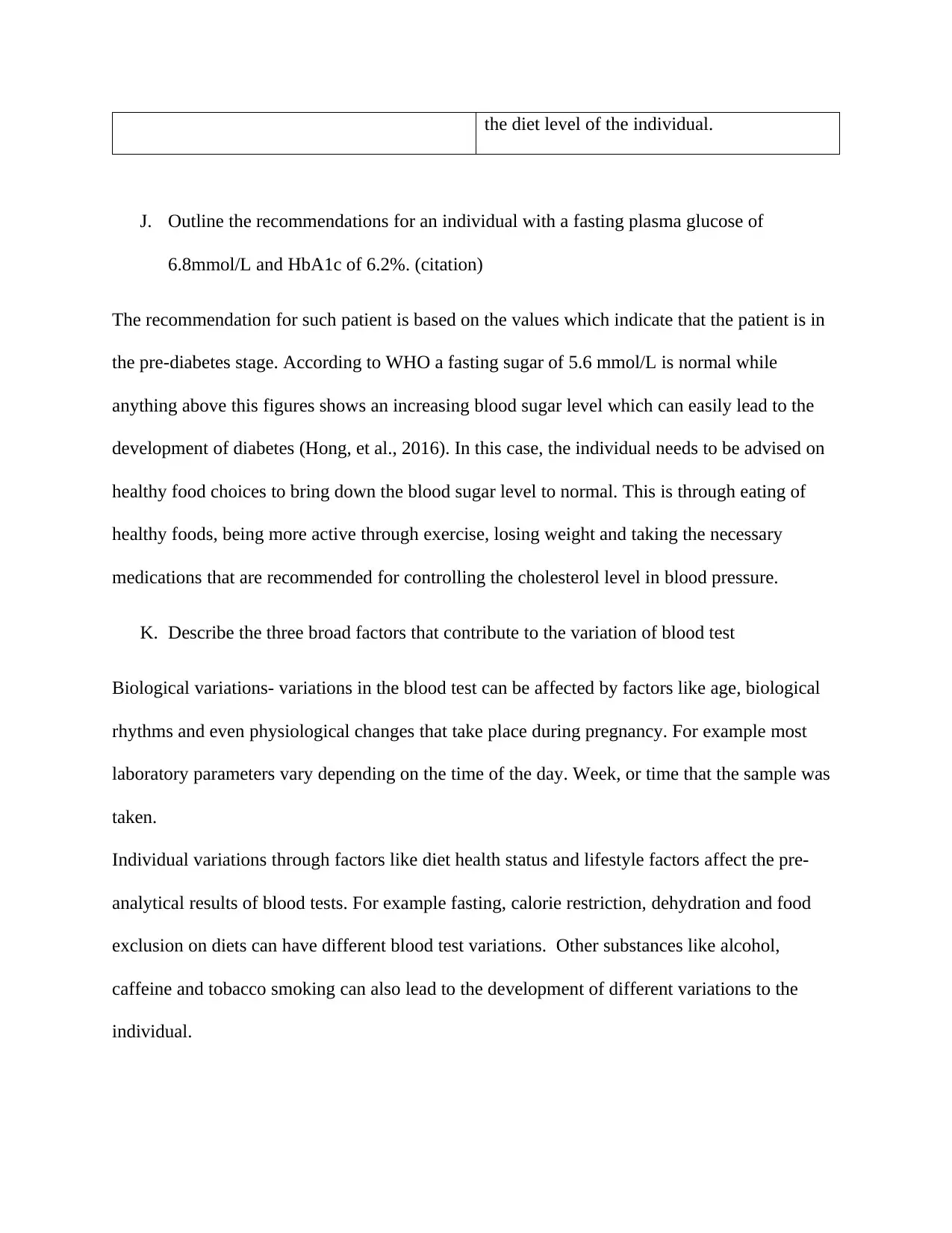
the diet level of the individual.
J. Outline the recommendations for an individual with a fasting plasma glucose of
6.8mmol/L and HbA1c of 6.2%. (citation)
The recommendation for such patient is based on the values which indicate that the patient is in
the pre-diabetes stage. According to WHO a fasting sugar of 5.6 mmol/L is normal while
anything above this figures shows an increasing blood sugar level which can easily lead to the
development of diabetes (Hong, et al., 2016). In this case, the individual needs to be advised on
healthy food choices to bring down the blood sugar level to normal. This is through eating of
healthy foods, being more active through exercise, losing weight and taking the necessary
medications that are recommended for controlling the cholesterol level in blood pressure.
K. Describe the three broad factors that contribute to the variation of blood test
Biological variations- variations in the blood test can be affected by factors like age, biological
rhythms and even physiological changes that take place during pregnancy. For example most
laboratory parameters vary depending on the time of the day. Week, or time that the sample was
taken.
Individual variations through factors like diet health status and lifestyle factors affect the pre-
analytical results of blood tests. For example fasting, calorie restriction, dehydration and food
exclusion on diets can have different blood test variations. Other substances like alcohol,
caffeine and tobacco smoking can also lead to the development of different variations to the
individual.
J. Outline the recommendations for an individual with a fasting plasma glucose of
6.8mmol/L and HbA1c of 6.2%. (citation)
The recommendation for such patient is based on the values which indicate that the patient is in
the pre-diabetes stage. According to WHO a fasting sugar of 5.6 mmol/L is normal while
anything above this figures shows an increasing blood sugar level which can easily lead to the
development of diabetes (Hong, et al., 2016). In this case, the individual needs to be advised on
healthy food choices to bring down the blood sugar level to normal. This is through eating of
healthy foods, being more active through exercise, losing weight and taking the necessary
medications that are recommended for controlling the cholesterol level in blood pressure.
K. Describe the three broad factors that contribute to the variation of blood test
Biological variations- variations in the blood test can be affected by factors like age, biological
rhythms and even physiological changes that take place during pregnancy. For example most
laboratory parameters vary depending on the time of the day. Week, or time that the sample was
taken.
Individual variations through factors like diet health status and lifestyle factors affect the pre-
analytical results of blood tests. For example fasting, calorie restriction, dehydration and food
exclusion on diets can have different blood test variations. Other substances like alcohol,
caffeine and tobacco smoking can also lead to the development of different variations to the
individual.
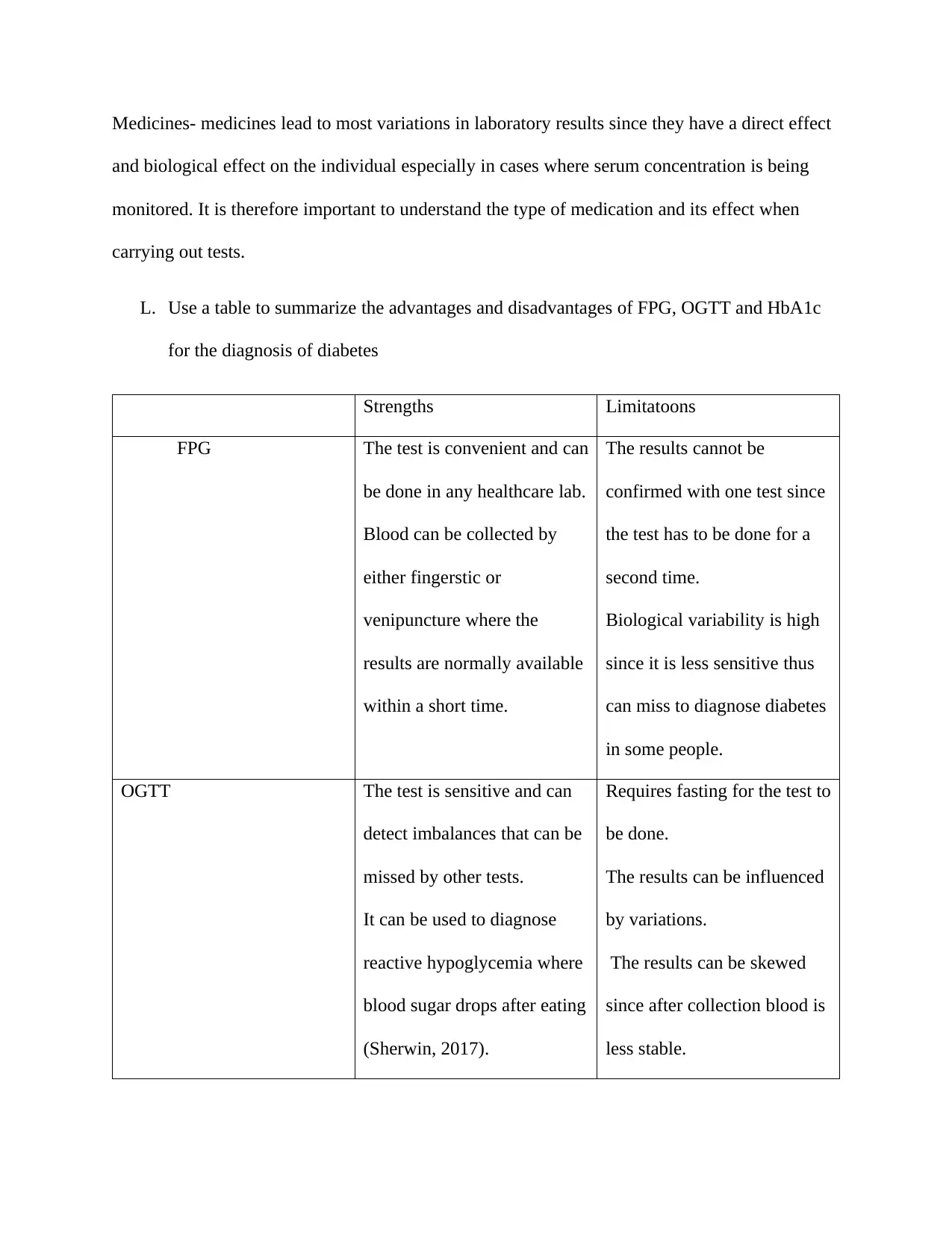
Medicines- medicines lead to most variations in laboratory results since they have a direct effect
and biological effect on the individual especially in cases where serum concentration is being
monitored. It is therefore important to understand the type of medication and its effect when
carrying out tests.
L. Use a table to summarize the advantages and disadvantages of FPG, OGTT and HbA1c
for the diagnosis of diabetes
Strengths Limitatoons
FPG The test is convenient and can
be done in any healthcare lab.
Blood can be collected by
either fingerstic or
venipuncture where the
results are normally available
within a short time.
The results cannot be
confirmed with one test since
the test has to be done for a
second time.
Biological variability is high
since it is less sensitive thus
can miss to diagnose diabetes
in some people.
OGTT The test is sensitive and can
detect imbalances that can be
missed by other tests.
It can be used to diagnose
reactive hypoglycemia where
blood sugar drops after eating
(Sherwin, 2017).
Requires fasting for the test to
be done.
The results can be influenced
by variations.
The results can be skewed
since after collection blood is
less stable.
and biological effect on the individual especially in cases where serum concentration is being
monitored. It is therefore important to understand the type of medication and its effect when
carrying out tests.
L. Use a table to summarize the advantages and disadvantages of FPG, OGTT and HbA1c
for the diagnosis of diabetes
Strengths Limitatoons
FPG The test is convenient and can
be done in any healthcare lab.
Blood can be collected by
either fingerstic or
venipuncture where the
results are normally available
within a short time.
The results cannot be
confirmed with one test since
the test has to be done for a
second time.
Biological variability is high
since it is less sensitive thus
can miss to diagnose diabetes
in some people.
OGTT The test is sensitive and can
detect imbalances that can be
missed by other tests.
It can be used to diagnose
reactive hypoglycemia where
blood sugar drops after eating
(Sherwin, 2017).
Requires fasting for the test to
be done.
The results can be influenced
by variations.
The results can be skewed
since after collection blood is
less stable.
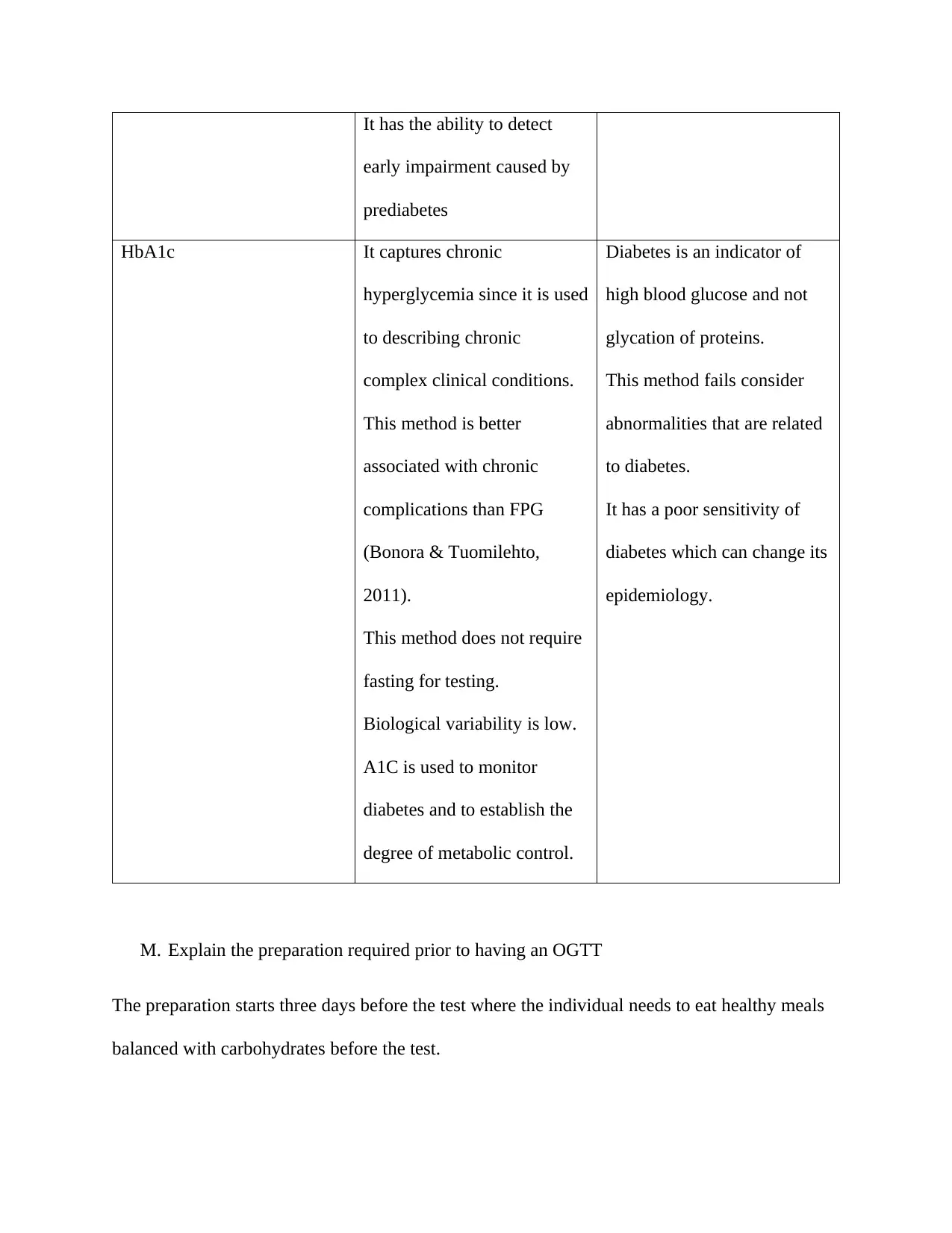
It has the ability to detect
early impairment caused by
prediabetes
HbA1c It captures chronic
hyperglycemia since it is used
to describing chronic
complex clinical conditions.
This method is better
associated with chronic
complications than FPG
(Bonora & Tuomilehto,
2011).
This method does not require
fasting for testing.
Biological variability is low.
A1C is used to monitor
diabetes and to establish the
degree of metabolic control.
Diabetes is an indicator of
high blood glucose and not
glycation of proteins.
This method fails consider
abnormalities that are related
to diabetes.
It has a poor sensitivity of
diabetes which can change its
epidemiology.
M. Explain the preparation required prior to having an OGTT
The preparation starts three days before the test where the individual needs to eat healthy meals
balanced with carbohydrates before the test.
early impairment caused by
prediabetes
HbA1c It captures chronic
hyperglycemia since it is used
to describing chronic
complex clinical conditions.
This method is better
associated with chronic
complications than FPG
(Bonora & Tuomilehto,
2011).
This method does not require
fasting for testing.
Biological variability is low.
A1C is used to monitor
diabetes and to establish the
degree of metabolic control.
Diabetes is an indicator of
high blood glucose and not
glycation of proteins.
This method fails consider
abnormalities that are related
to diabetes.
It has a poor sensitivity of
diabetes which can change its
epidemiology.
M. Explain the preparation required prior to having an OGTT
The preparation starts three days before the test where the individual needs to eat healthy meals
balanced with carbohydrates before the test.
Paraphrase This Document
Need a fresh take? Get an instant paraphrase of this document with our AI Paraphraser
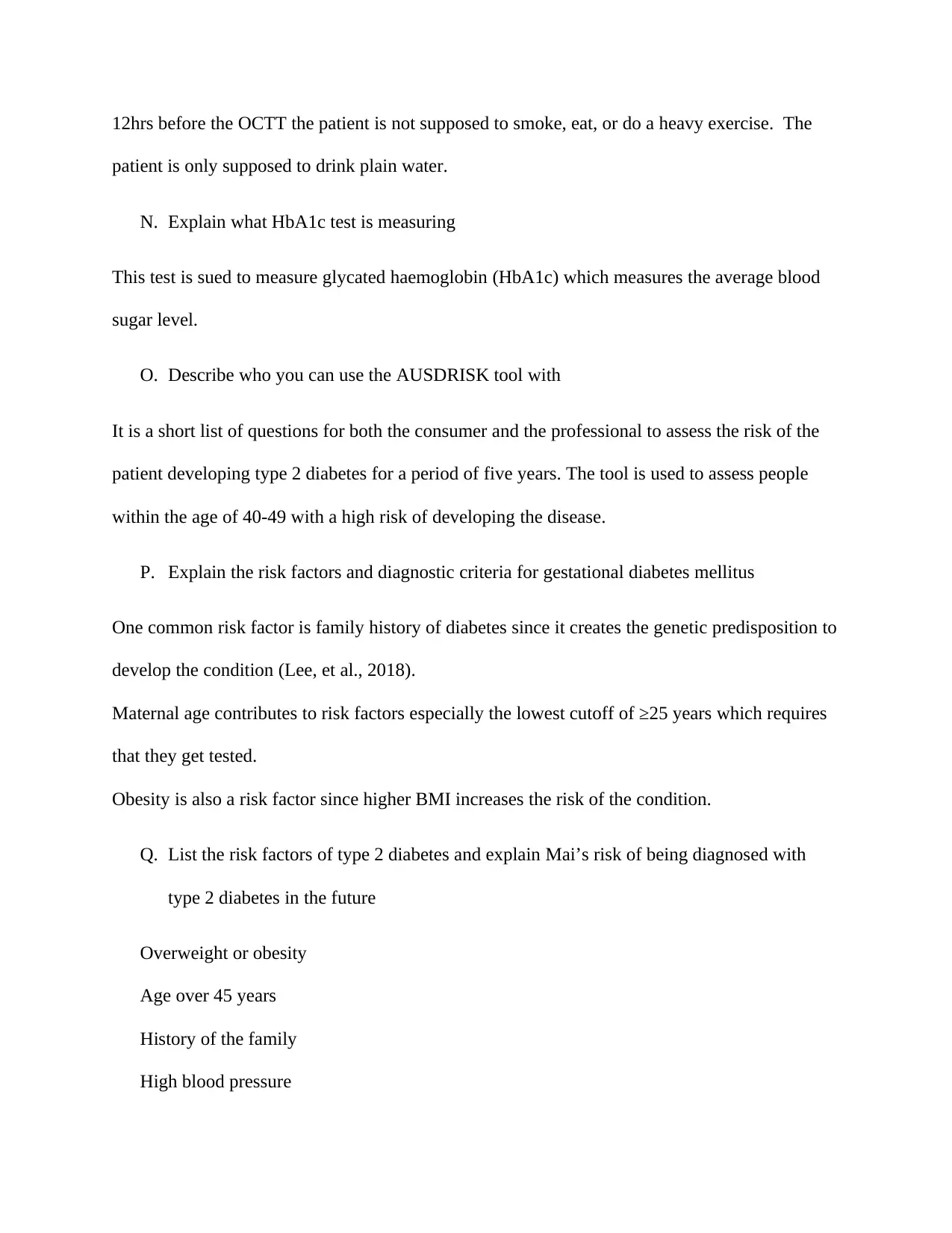
12hrs before the OCTT the patient is not supposed to smoke, eat, or do a heavy exercise. The
patient is only supposed to drink plain water.
N. Explain what HbA1c test is measuring
This test is sued to measure glycated haemoglobin (HbA1c) which measures the average blood
sugar level.
O. Describe who you can use the AUSDRISK tool with
It is a short list of questions for both the consumer and the professional to assess the risk of the
patient developing type 2 diabetes for a period of five years. The tool is used to assess people
within the age of 40-49 with a high risk of developing the disease.
P. Explain the risk factors and diagnostic criteria for gestational diabetes mellitus
One common risk factor is family history of diabetes since it creates the genetic predisposition to
develop the condition (Lee, et al., 2018).
Maternal age contributes to risk factors especially the lowest cutoff of ≥25 years which requires
that they get tested.
Obesity is also a risk factor since higher BMI increases the risk of the condition.
Q. List the risk factors of type 2 diabetes and explain Mai’s risk of being diagnosed with
type 2 diabetes in the future
Overweight or obesity
Age over 45 years
History of the family
High blood pressure
patient is only supposed to drink plain water.
N. Explain what HbA1c test is measuring
This test is sued to measure glycated haemoglobin (HbA1c) which measures the average blood
sugar level.
O. Describe who you can use the AUSDRISK tool with
It is a short list of questions for both the consumer and the professional to assess the risk of the
patient developing type 2 diabetes for a period of five years. The tool is used to assess people
within the age of 40-49 with a high risk of developing the disease.
P. Explain the risk factors and diagnostic criteria for gestational diabetes mellitus
One common risk factor is family history of diabetes since it creates the genetic predisposition to
develop the condition (Lee, et al., 2018).
Maternal age contributes to risk factors especially the lowest cutoff of ≥25 years which requires
that they get tested.
Obesity is also a risk factor since higher BMI increases the risk of the condition.
Q. List the risk factors of type 2 diabetes and explain Mai’s risk of being diagnosed with
type 2 diabetes in the future
Overweight or obesity
Age over 45 years
History of the family
High blood pressure
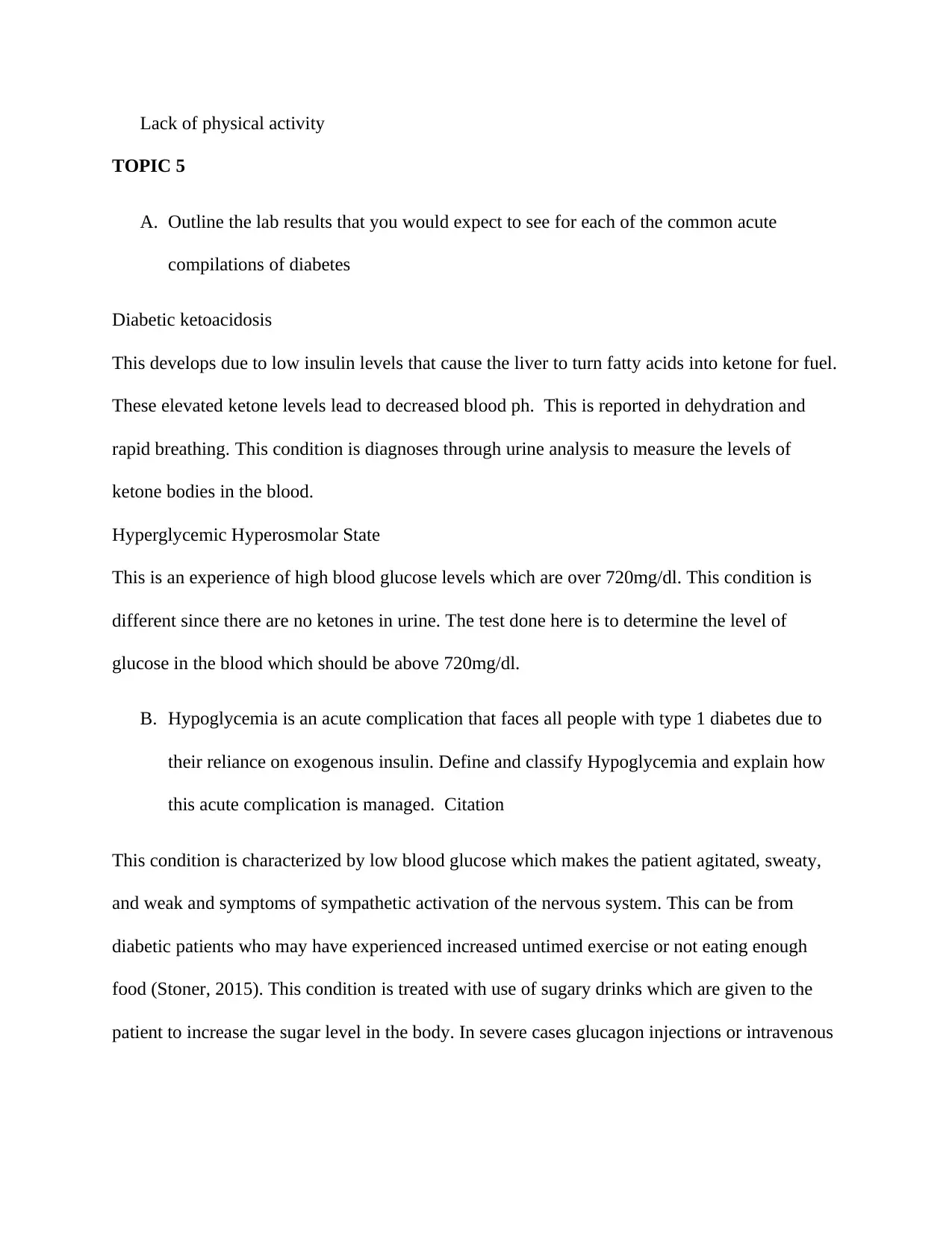
Lack of physical activity
TOPIC 5
A. Outline the lab results that you would expect to see for each of the common acute
compilations of diabetes
Diabetic ketoacidosis
This develops due to low insulin levels that cause the liver to turn fatty acids into ketone for fuel.
These elevated ketone levels lead to decreased blood ph. This is reported in dehydration and
rapid breathing. This condition is diagnoses through urine analysis to measure the levels of
ketone bodies in the blood.
Hyperglycemic Hyperosmolar State
This is an experience of high blood glucose levels which are over 720mg/dl. This condition is
different since there are no ketones in urine. The test done here is to determine the level of
glucose in the blood which should be above 720mg/dl.
B. Hypoglycemia is an acute complication that faces all people with type 1 diabetes due to
their reliance on exogenous insulin. Define and classify Hypoglycemia and explain how
this acute complication is managed. Citation
This condition is characterized by low blood glucose which makes the patient agitated, sweaty,
and weak and symptoms of sympathetic activation of the nervous system. This can be from
diabetic patients who may have experienced increased untimed exercise or not eating enough
food (Stoner, 2015). This condition is treated with use of sugary drinks which are given to the
patient to increase the sugar level in the body. In severe cases glucagon injections or intravenous
TOPIC 5
A. Outline the lab results that you would expect to see for each of the common acute
compilations of diabetes
Diabetic ketoacidosis
This develops due to low insulin levels that cause the liver to turn fatty acids into ketone for fuel.
These elevated ketone levels lead to decreased blood ph. This is reported in dehydration and
rapid breathing. This condition is diagnoses through urine analysis to measure the levels of
ketone bodies in the blood.
Hyperglycemic Hyperosmolar State
This is an experience of high blood glucose levels which are over 720mg/dl. This condition is
different since there are no ketones in urine. The test done here is to determine the level of
glucose in the blood which should be above 720mg/dl.
B. Hypoglycemia is an acute complication that faces all people with type 1 diabetes due to
their reliance on exogenous insulin. Define and classify Hypoglycemia and explain how
this acute complication is managed. Citation
This condition is characterized by low blood glucose which makes the patient agitated, sweaty,
and weak and symptoms of sympathetic activation of the nervous system. This can be from
diabetic patients who may have experienced increased untimed exercise or not eating enough
food (Stoner, 2015). This condition is treated with use of sugary drinks which are given to the
patient to increase the sugar level in the body. In severe cases glucagon injections or intravenous
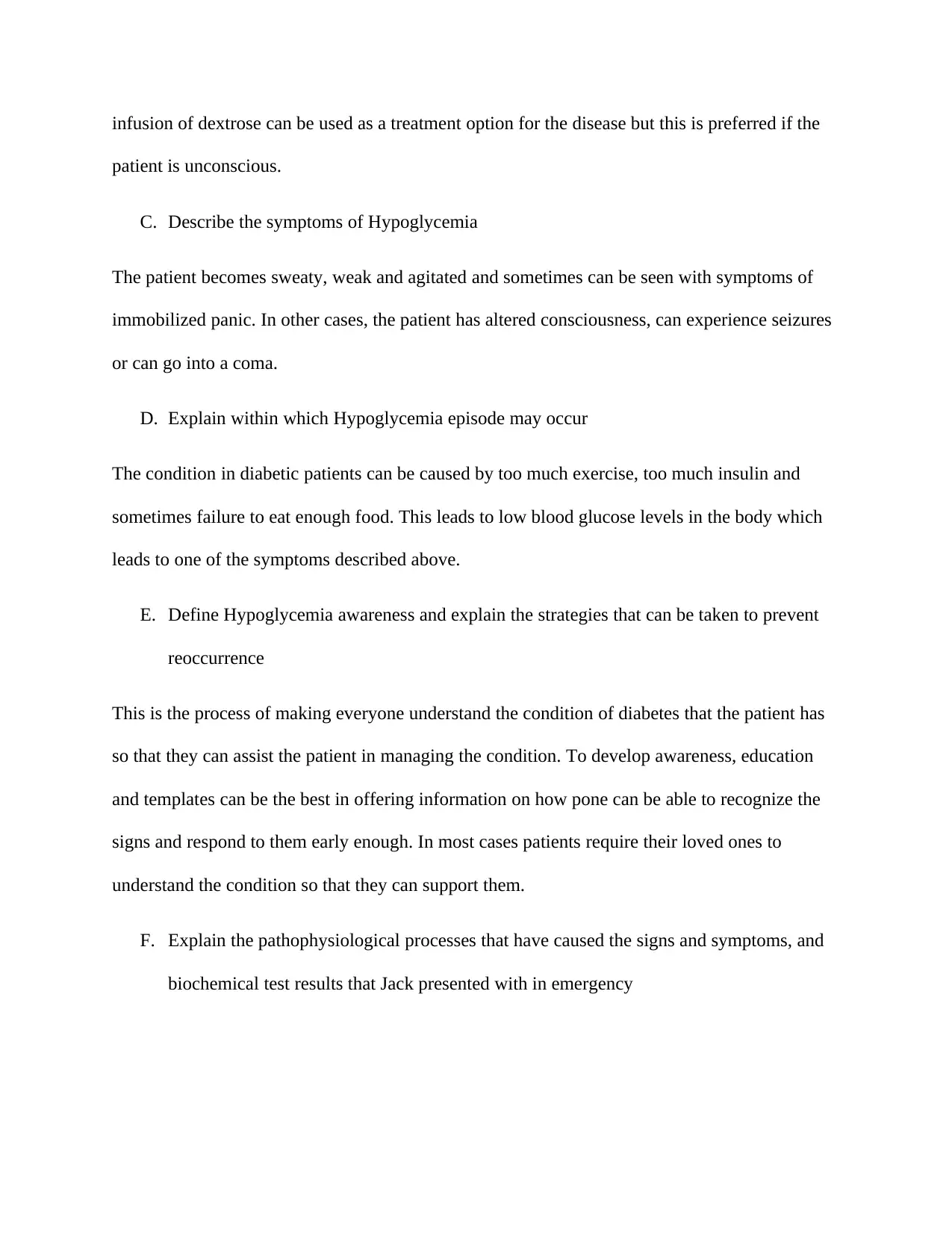
infusion of dextrose can be used as a treatment option for the disease but this is preferred if the
patient is unconscious.
C. Describe the symptoms of Hypoglycemia
The patient becomes sweaty, weak and agitated and sometimes can be seen with symptoms of
immobilized panic. In other cases, the patient has altered consciousness, can experience seizures
or can go into a coma.
D. Explain within which Hypoglycemia episode may occur
The condition in diabetic patients can be caused by too much exercise, too much insulin and
sometimes failure to eat enough food. This leads to low blood glucose levels in the body which
leads to one of the symptoms described above.
E. Define Hypoglycemia awareness and explain the strategies that can be taken to prevent
reoccurrence
This is the process of making everyone understand the condition of diabetes that the patient has
so that they can assist the patient in managing the condition. To develop awareness, education
and templates can be the best in offering information on how pone can be able to recognize the
signs and respond to them early enough. In most cases patients require their loved ones to
understand the condition so that they can support them.
F. Explain the pathophysiological processes that have caused the signs and symptoms, and
biochemical test results that Jack presented with in emergency
patient is unconscious.
C. Describe the symptoms of Hypoglycemia
The patient becomes sweaty, weak and agitated and sometimes can be seen with symptoms of
immobilized panic. In other cases, the patient has altered consciousness, can experience seizures
or can go into a coma.
D. Explain within which Hypoglycemia episode may occur
The condition in diabetic patients can be caused by too much exercise, too much insulin and
sometimes failure to eat enough food. This leads to low blood glucose levels in the body which
leads to one of the symptoms described above.
E. Define Hypoglycemia awareness and explain the strategies that can be taken to prevent
reoccurrence
This is the process of making everyone understand the condition of diabetes that the patient has
so that they can assist the patient in managing the condition. To develop awareness, education
and templates can be the best in offering information on how pone can be able to recognize the
signs and respond to them early enough. In most cases patients require their loved ones to
understand the condition so that they can support them.
F. Explain the pathophysiological processes that have caused the signs and symptoms, and
biochemical test results that Jack presented with in emergency
Secure Best Marks with AI Grader
Need help grading? Try our AI Grader for instant feedback on your assignments.
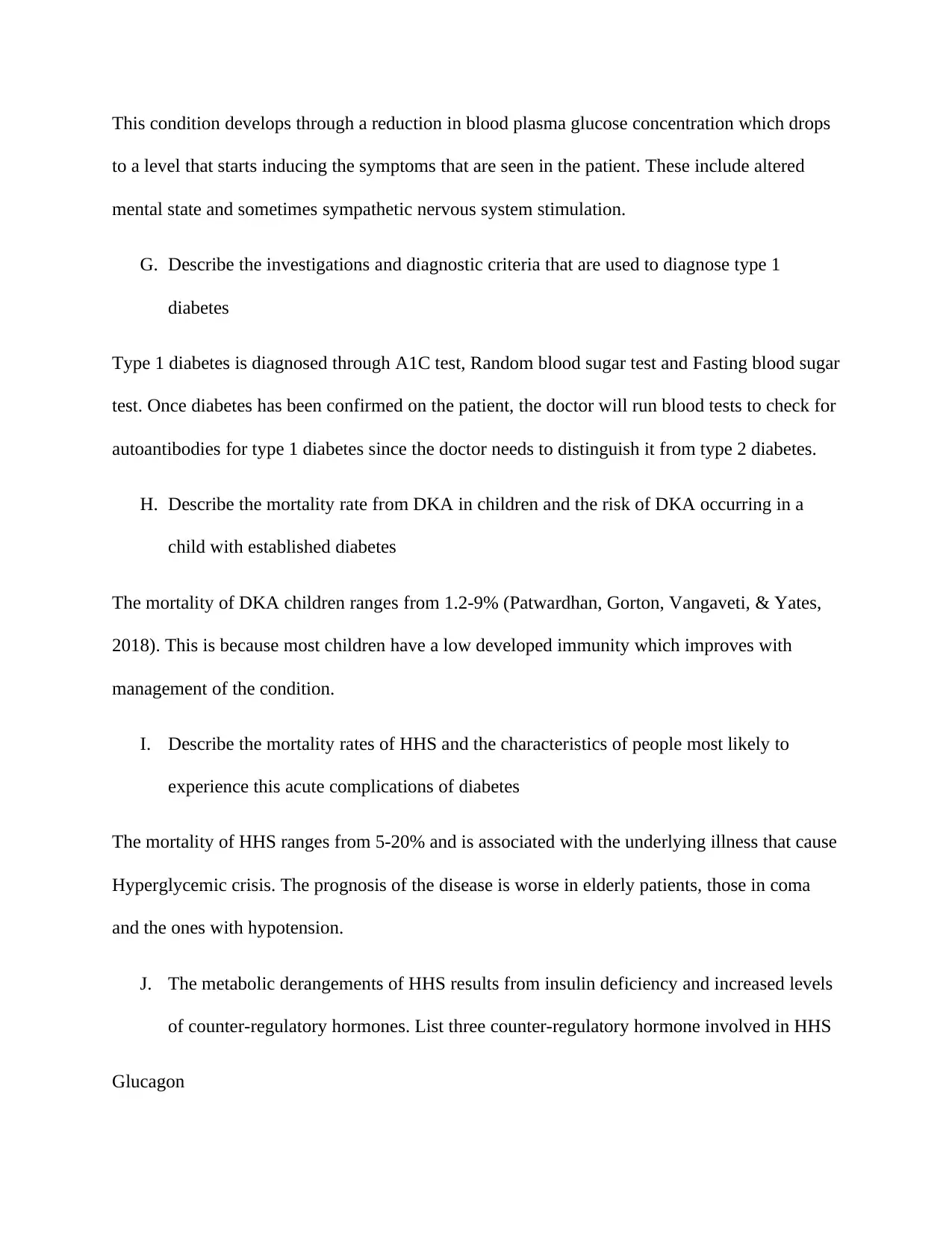
This condition develops through a reduction in blood plasma glucose concentration which drops
to a level that starts inducing the symptoms that are seen in the patient. These include altered
mental state and sometimes sympathetic nervous system stimulation.
G. Describe the investigations and diagnostic criteria that are used to diagnose type 1
diabetes
Type 1 diabetes is diagnosed through A1C test, Random blood sugar test and Fasting blood sugar
test. Once diabetes has been confirmed on the patient, the doctor will run blood tests to check for
autoantibodies for type 1 diabetes since the doctor needs to distinguish it from type 2 diabetes.
H. Describe the mortality rate from DKA in children and the risk of DKA occurring in a
child with established diabetes
The mortality of DKA children ranges from 1.2-9% (Patwardhan, Gorton, Vangaveti, & Yates,
2018). This is because most children have a low developed immunity which improves with
management of the condition.
I. Describe the mortality rates of HHS and the characteristics of people most likely to
experience this acute complications of diabetes
The mortality of HHS ranges from 5-20% and is associated with the underlying illness that cause
Hyperglycemic crisis. The prognosis of the disease is worse in elderly patients, those in coma
and the ones with hypotension.
J. The metabolic derangements of HHS results from insulin deficiency and increased levels
of counter-regulatory hormones. List three counter-regulatory hormone involved in HHS
Glucagon
to a level that starts inducing the symptoms that are seen in the patient. These include altered
mental state and sometimes sympathetic nervous system stimulation.
G. Describe the investigations and diagnostic criteria that are used to diagnose type 1
diabetes
Type 1 diabetes is diagnosed through A1C test, Random blood sugar test and Fasting blood sugar
test. Once diabetes has been confirmed on the patient, the doctor will run blood tests to check for
autoantibodies for type 1 diabetes since the doctor needs to distinguish it from type 2 diabetes.
H. Describe the mortality rate from DKA in children and the risk of DKA occurring in a
child with established diabetes
The mortality of DKA children ranges from 1.2-9% (Patwardhan, Gorton, Vangaveti, & Yates,
2018). This is because most children have a low developed immunity which improves with
management of the condition.
I. Describe the mortality rates of HHS and the characteristics of people most likely to
experience this acute complications of diabetes
The mortality of HHS ranges from 5-20% and is associated with the underlying illness that cause
Hyperglycemic crisis. The prognosis of the disease is worse in elderly patients, those in coma
and the ones with hypotension.
J. The metabolic derangements of HHS results from insulin deficiency and increased levels
of counter-regulatory hormones. List three counter-regulatory hormone involved in HHS
Glucagon
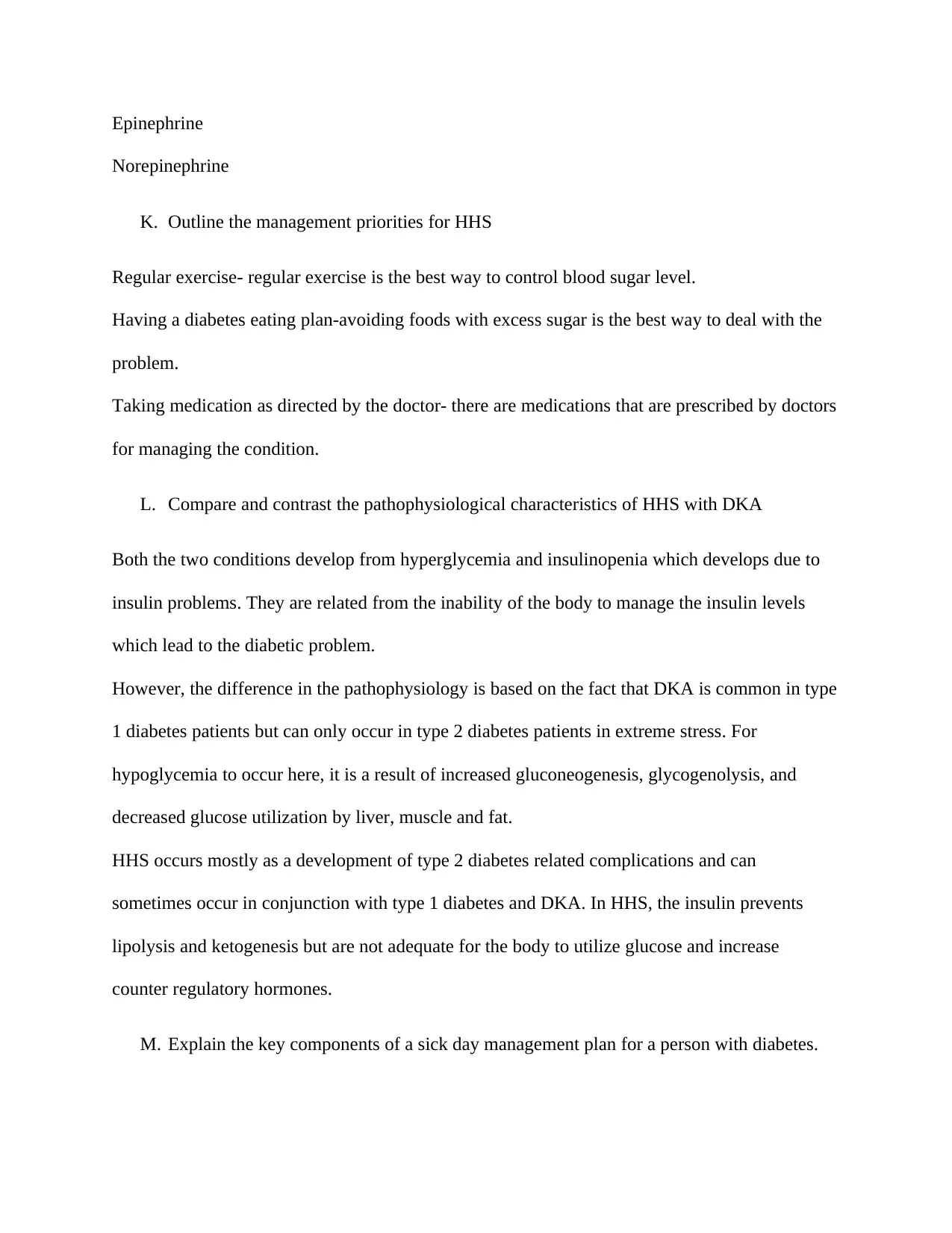
Epinephrine
Norepinephrine
K. Outline the management priorities for HHS
Regular exercise- regular exercise is the best way to control blood sugar level.
Having a diabetes eating plan-avoiding foods with excess sugar is the best way to deal with the
problem.
Taking medication as directed by the doctor- there are medications that are prescribed by doctors
for managing the condition.
L. Compare and contrast the pathophysiological characteristics of HHS with DKA
Both the two conditions develop from hyperglycemia and insulinopenia which develops due to
insulin problems. They are related from the inability of the body to manage the insulin levels
which lead to the diabetic problem.
However, the difference in the pathophysiology is based on the fact that DKA is common in type
1 diabetes patients but can only occur in type 2 diabetes patients in extreme stress. For
hypoglycemia to occur here, it is a result of increased gluconeogenesis, glycogenolysis, and
decreased glucose utilization by liver, muscle and fat.
HHS occurs mostly as a development of type 2 diabetes related complications and can
sometimes occur in conjunction with type 1 diabetes and DKA. In HHS, the insulin prevents
lipolysis and ketogenesis but are not adequate for the body to utilize glucose and increase
counter regulatory hormones.
M. Explain the key components of a sick day management plan for a person with diabetes.
Norepinephrine
K. Outline the management priorities for HHS
Regular exercise- regular exercise is the best way to control blood sugar level.
Having a diabetes eating plan-avoiding foods with excess sugar is the best way to deal with the
problem.
Taking medication as directed by the doctor- there are medications that are prescribed by doctors
for managing the condition.
L. Compare and contrast the pathophysiological characteristics of HHS with DKA
Both the two conditions develop from hyperglycemia and insulinopenia which develops due to
insulin problems. They are related from the inability of the body to manage the insulin levels
which lead to the diabetic problem.
However, the difference in the pathophysiology is based on the fact that DKA is common in type
1 diabetes patients but can only occur in type 2 diabetes patients in extreme stress. For
hypoglycemia to occur here, it is a result of increased gluconeogenesis, glycogenolysis, and
decreased glucose utilization by liver, muscle and fat.
HHS occurs mostly as a development of type 2 diabetes related complications and can
sometimes occur in conjunction with type 1 diabetes and DKA. In HHS, the insulin prevents
lipolysis and ketogenesis but are not adequate for the body to utilize glucose and increase
counter regulatory hormones.
M. Explain the key components of a sick day management plan for a person with diabetes.
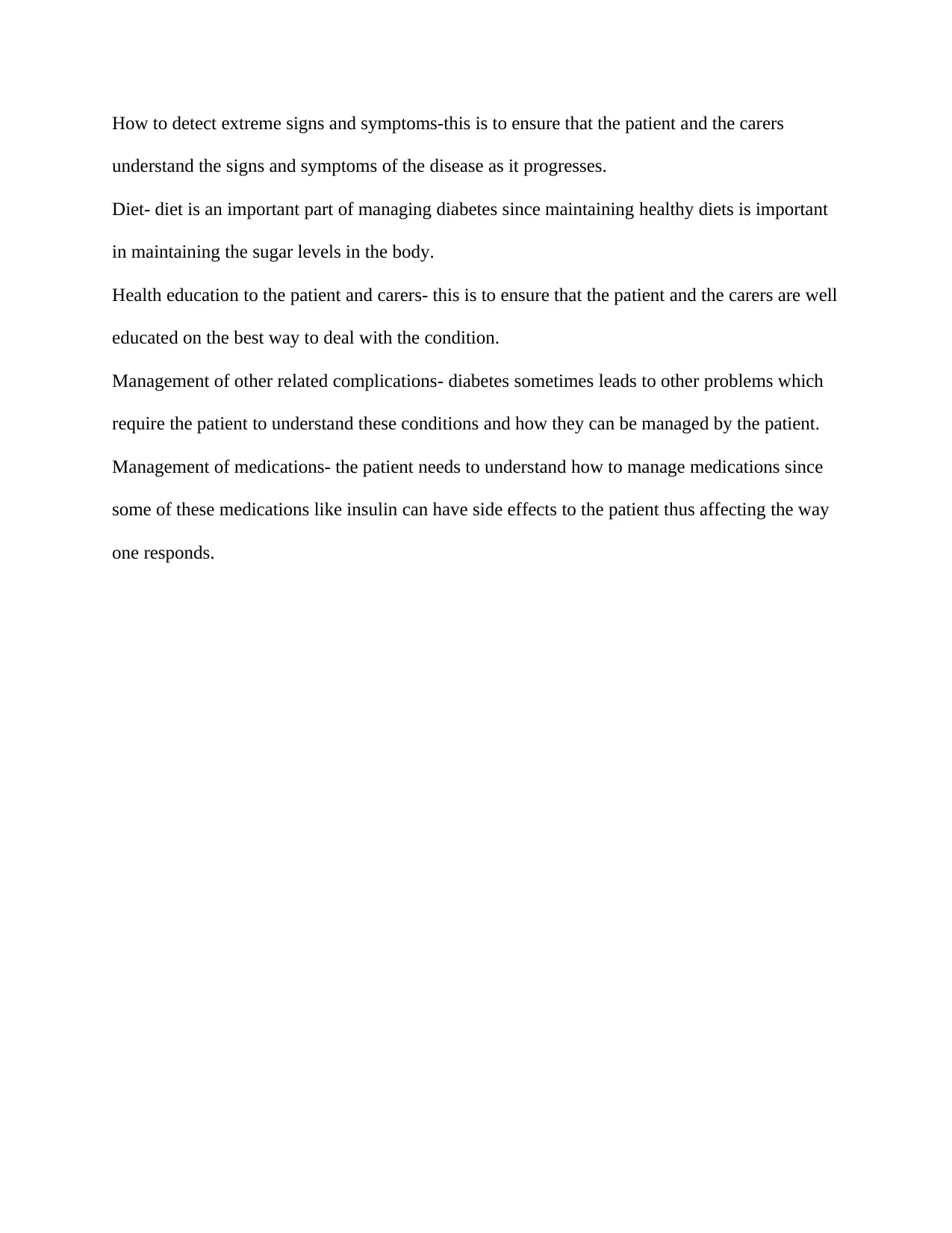
How to detect extreme signs and symptoms-this is to ensure that the patient and the carers
understand the signs and symptoms of the disease as it progresses.
Diet- diet is an important part of managing diabetes since maintaining healthy diets is important
in maintaining the sugar levels in the body.
Health education to the patient and carers- this is to ensure that the patient and the carers are well
educated on the best way to deal with the condition.
Management of other related complications- diabetes sometimes leads to other problems which
require the patient to understand these conditions and how they can be managed by the patient.
Management of medications- the patient needs to understand how to manage medications since
some of these medications like insulin can have side effects to the patient thus affecting the way
one responds.
understand the signs and symptoms of the disease as it progresses.
Diet- diet is an important part of managing diabetes since maintaining healthy diets is important
in maintaining the sugar levels in the body.
Health education to the patient and carers- this is to ensure that the patient and the carers are well
educated on the best way to deal with the condition.
Management of other related complications- diabetes sometimes leads to other problems which
require the patient to understand these conditions and how they can be managed by the patient.
Management of medications- the patient needs to understand how to manage medications since
some of these medications like insulin can have side effects to the patient thus affecting the way
one responds.
Paraphrase This Document
Need a fresh take? Get an instant paraphrase of this document with our AI Paraphraser
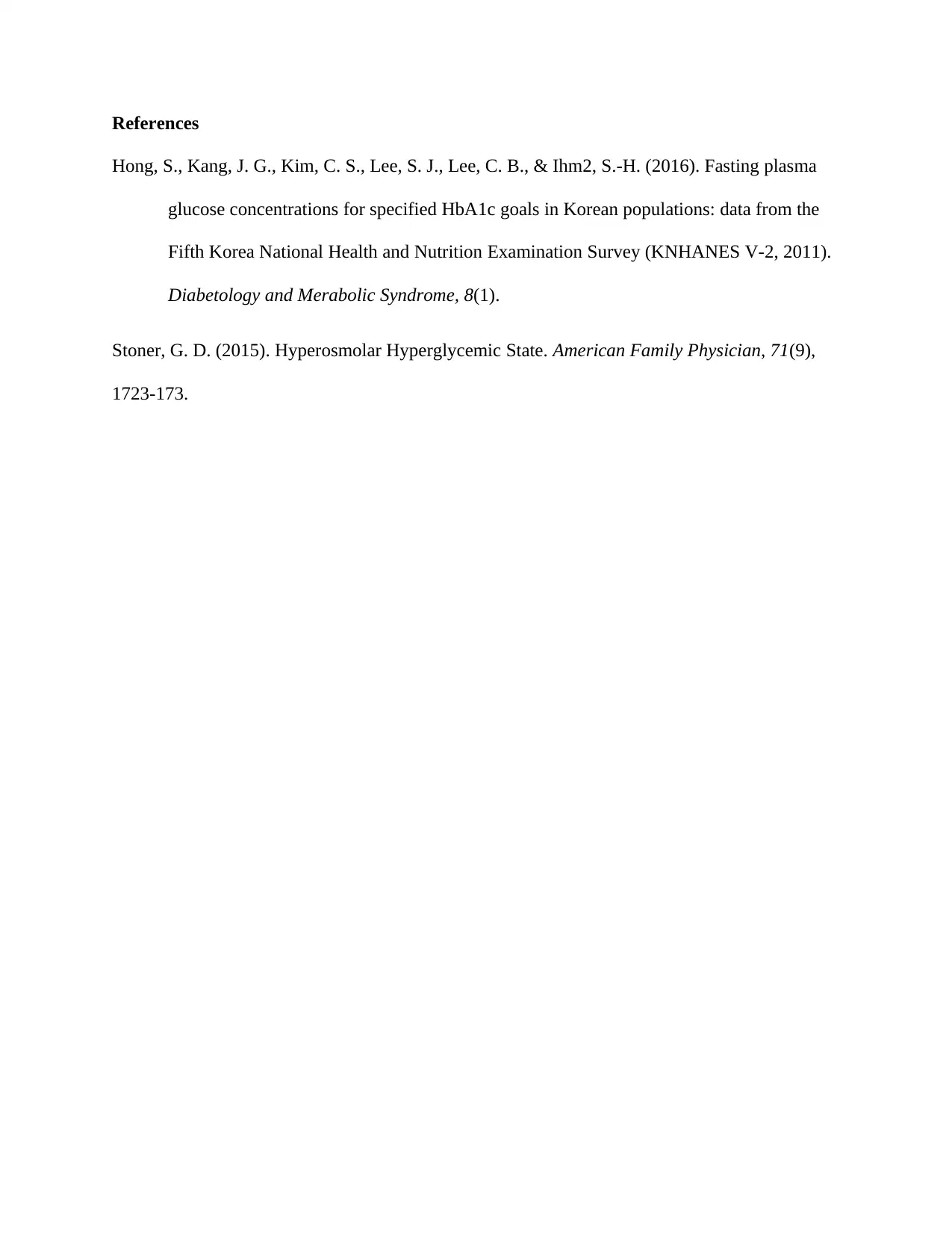
References
Hong, S., Kang, J. G., Kim, C. S., Lee, S. J., Lee, C. B., & Ihm2, S.-H. (2016). Fasting plasma
glucose concentrations for specified HbA1c goals in Korean populations: data from the
Fifth Korea National Health and Nutrition Examination Survey (KNHANES V-2, 2011).
Diabetology and Merabolic Syndrome, 8(1).
Stoner, G. D. (2015). Hyperosmolar Hyperglycemic State. American Family Physician, 71(9),
1723-173.
Hong, S., Kang, J. G., Kim, C. S., Lee, S. J., Lee, C. B., & Ihm2, S.-H. (2016). Fasting plasma
glucose concentrations for specified HbA1c goals in Korean populations: data from the
Fifth Korea National Health and Nutrition Examination Survey (KNHANES V-2, 2011).
Diabetology and Merabolic Syndrome, 8(1).
Stoner, G. D. (2015). Hyperosmolar Hyperglycemic State. American Family Physician, 71(9),
1723-173.
1 out of 14
Related Documents
Your All-in-One AI-Powered Toolkit for Academic Success.
+13062052269
info@desklib.com
Available 24*7 on WhatsApp / Email
![[object Object]](/_next/static/media/star-bottom.7253800d.svg)
Unlock your academic potential
© 2024 | Zucol Services PVT LTD | All rights reserved.





